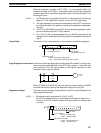
312
D+1 contains the bit address code of the input condition, as shown below.
The word addresses, bit numbers, and TC numbers are in binary.
Data
D+1 bit status
area
15 14 13 12 11 10 09 08 07 06 05 04 03 02 01 00
IR, SR 1 0 0 0 Word address Bit number
(see
note c)
1 0 1 0 Word address Bit number
HR 1 0 0 1 1 Word address Bit number
LR 1 0 0 1 0 0 Word address Bit number
TC* 1 0 0 1 0 1 * Timer or counter number
Note a) *For the TC area, bit 09 of D+1 indicates whether the number is a
timer or counter. A 0 indicates a timer, and a 1 indicates a counter.
b) The status of the leftmost bit of the bit number (bit 03) is reversed.
c) Although the same word address designations are used for both
ranges, bit 13 is turned OFF to indicate IR 00000 through SR
25515 and turned ON to indicate SR 25600 through IR 51115
Example: If D + 1 contains 1000 0110 0100 1000, IR 10000 would be indi-
cated as follows:
1000 0110 0100 1000
IR $64 = 100 Bit 00 (inverting status of bit 03)
2. Bit address and message output (used when bit 15 of C is ON).
Bit 15 of D indicates whether or not there is bit address information stored in
D+1 to D+3. If there is, bit 14 of D indicates whether the input condition is
normally open or closed. Refer to the following table.
Words D+5 to D+8 contain information in ASCII that are displayed on a Pe-
ripheral Device along with the bit address when FPD(––) is executed.
Words D+5 to D+8 contain the message preset by the user as shown in the
following table.
Word Bits 15 to 08 Bits 07 to 00
D+1 20 = space First ASCII character of bit address
D+2 Second ASCII character of bit address Third ASCII character of bit address
D+3 Fourth ASCII character of bit address Fifth ASCII character of bit address
D+4 2D = “–” “0”=normally open,
“1”=normally closed
D+5 First ASCII character of message Second ASCII character of message
D+6 Third ASCII character of message Fourth ASCII character of message
D+7 Fifth ASCII character of message Sixth ASCII character of message
D+8 Seventh ASCII character of message Eighth ASCII character of message
Note If 8 characters are not needed in the message, input “0D” after the
last character.
Determining Monitoring Time The procedure below can be used to automatically set the monitoring time, T,
under actual operating conditions when specifying a word operand for T. This
operation cannot be used if a constant is set for T.
1, 2, 3... 1. Switch the PC to MONITOR Mode operation.
2. Connect a Peripheral Device, such as a Programming Console.
3. Use the Peripheral Device to turn ON control bit AR 2508.
4. Execute the program with AR 2508 turned ON. If the monitoring time cur-
rently in T is exceeded, 1.5 times the actual monitoring time will be stored in
T. FAL(06) errors will not occur while AR 2508 is ON.
5. Turn OFF AR 2508 when an acceptable value has been stored in T.
Special Instructions Section 5-25


















